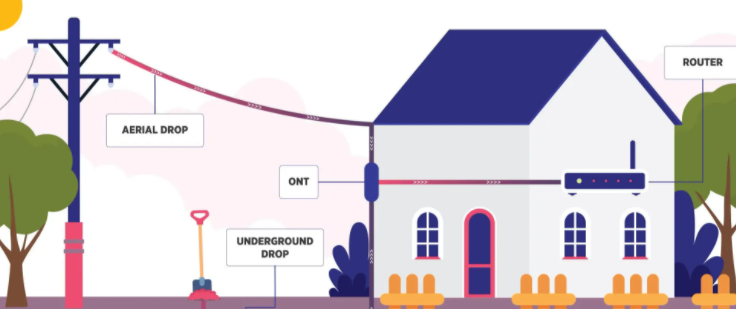OKÚLÌ
Àdírẹ́sì: Shenyang, Liaoning, Ṣáínà
Ẹnì kan tó kàn sílẹ̀: Alábòójútó Zhang
Fóònù: 400-964-1314
Fóònù alábòójútó: 86 1390405338
?
2025-10-07 48
Aerial Kàbàdàra optic fibre installation is a common and cost-effective deployment method in communication network construction. However, it's noteworthy that many construction teams often overlook details during implementation, leading to increased maintenance costs later. In a 2023 mountain region project, our team improved the efficiency of aerial cable installation by 40% through process optimization. Today, I'll share a complete guide to help you avoid common pitfalls.

Basic Concepts of Aerial Fiber Optic Cables
Aerial fiber installation refers to the method of stringing cables overhead using existing utility poles or new support structures. This approach offers lower costs and shorter construction cycles, making it particularly suitable for complex terrains. For example, in mountainous areas or river crossings, aerial installation is Pẹlẹbẹ economical than direct burial. However, environmental factors like wind vibration and ice load must be considered.Www.adsscable.cn
Advantages and Limitations of Aerial Installation
| Aspect | Advantages | Limitations |
|---|---|---|
| Cost | 30-50% lower than buried cables | Highly affected by weather |
| Construction Cycle | Typically 2-4 weeks | Requires right-of-way approvals |
| Maintenance | Easy fault localization | Vulnerable to external damage |
| Suitable Scenarios | Rural, mountainous areas | Limited use in urban centers |
5 Key Construction Steps
Step 1: Preliminary Survey and Planning
A detailed site survey must be conducted before construction. Specifically, record data such as pole positions, spacing, and terrain elevation. According to TIA-758 standards, pole spacing should typically be 50-70 meters. Our team has found that neglecting terrain elevation measurements can lead to errors in sag calculation.
Step 2: Material Selection and Preparation
Choosing the right cable type for the aerial environment is crucial. ADSS (All-Dielectric Self-Supporting) cables are a common choice as they don't require messenger wires. Counterintuitively, non-metallic cables are safer in lightning-prone areas. Also, prepare accessories like hardware and clamps.
Step 3: Pole and Support Structure Installation
Ensure poles are buried to the required depth during installation. For instance, an 8-meter pole should be buried 1.5 meters deep. Specifically, pole spacing errors should be controlled within ±5%. Remember to install reinforced poles at turning points.
Step 4: Cable Stringing and Fixing
Use dedicated cable reels during stringing to avoid twisting. Cable sag must be precisely controlled - according to EIA/TIA-758 standards, sag error should be within ±10% of the design value. Use specialized hardware for fixation to prevent stress concentration.
Step 5: Splicing and Testing
Splice points should be located on poles for easy maintenance. Use OTDR to test attenuation, with single splice loss less than 0.1dB. After testing, ensure proper waterproof sealing.
Common Construction Mistakes
⚠ Warning: The following mistakes can lead to serious consequences:
Www.adsscable.cn
Neglecting sag calculation, causing cable breaks in severe weather
Using mismatched hardware, resulting in micro-bend loss
Ignoring temperature variations, leading to over-tightening in winter
Case Study
In a 2023 mountain region broadband project, we used ADSS cables for aerial installation. The initial plan overlooked terrain elevation differences, resulting in insufficient sag at multiple points. Through recalculation and adjustment of suspension points, the loss eventually met standards. This case highlights the importance of preliminary planning.
Maintenance and Monitoring
Regular inspections are needed after installation. Specifically, check hardware for corrosion quarterly and conduct full-length testing annually. In typhoon-prone areas, reinforce inspection of fixation points. Our team developed an intelligent monitoring system that can track cable strain in real-time.
Cost Optimization Suggestions
Control costs through:
Reasonable route planning to reduce pole count
Selecting cables suitable for local climate
Bulk purchasing standard components
Adopting mechanized construction
Scheduling construction seasons appropriately
Checklist
Complete site survey report
Confirm cable type meets environmental requirements
Verify strength of all support structures
Validate sag calculation results
Test splice point lossWww.adsscable.cn
Complete waterproof sealing
Organize completion documentation
Conclusion
Aerial Kàbàdàra optic fibre installation requires systematic planning and precise execution. By following these steps, you can ensure project quality and extend service life. Remember, every detail affects overall network reliability. Start applying these insights today!
Q: What is the primary risk in aerial fiber installation?
A: Mainly severe weather impacts and external damage, requiring proper mechanical strength design and protective measures.
Q: How is utility pole spacing generally determined?
A: Typically 50-70 meters, considering cable weight, climate conditions, and terrain factors.
Q: Which areas are unsuitable for aerial installation?
A: Urban core areas, airport clearance zones, and heavy ice regions, where strict restrictions apply.
Q: What is the typical service life of aerial fiber cables?
A: Design life is usually 25 years, but actual lifespan depends on maintenance quality and operating environment.
Q: How to determine if existing poles can be reused?
A: Professional inspection is needed, including decay assessment, tilt measurement, and load-bearing capacity evaluation.